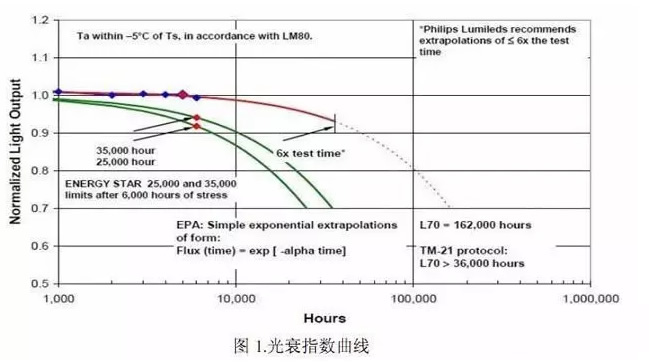01. Calculation basis: Arrhenius model
1. P=P0exp(-βt)
2. β=β 0 IFexp(-Ea/KTj)
Where: P0 is the initial test luminous flux. P is the luminous flux after heating and heating; β is the decay coefficient of a certain temperature. t is the power-on working time at a certain temperature;
Β0 is a constant; Ea is the activation energy; K is the Boltzmann constant; IF is the operating current; Tj is the junction temperature:
02. Inferred from the light decay of a thousand hours
Assuming a 1000-hour light decay luminous decay rate of n%, a formula of 50% light decay can be obtained: t=1000*ln0.5/ln (1-n%)
Formula 3 can get 30% light decay formula: t=1000*ln0.7/ln(1-n%)
Project 1000 hours light decay 50% light decay life (h) 30% light decay life (h)
(1) 85 degrees Celsius 8% 8312.950414 4277.62127
(2) 70 degrees Celsius 3% 22756.57306 11709.922
03. Calculate the LED lifetime at other temperatures. (The above temperature refers to the surface temperature at the contact between the bottom of the LED lamp and the circuit board. When the heat dissipation condition is sufficient, it is the ambient temperature. When the temperature is 350mA, the junction temperature is 15 degrees Celsius higher than the ambient temperature.)
It is assumed that the lifetime of a certain LED temperature T1 (degrees Celsius) is known as t1, and the lifetime when the temperature T2 (degrees Celsius) is t2. Equation 2 can be obtained The lifetime t3 under the condition of temperature T3 is:
T3=t1*exp(ln(t2/t1)/(1/(T2+15+273)-1/(T1+15+273))*(1/(T3+15+273)-1/(T1 +15+273)))
Project Life at 85 degrees Celsius (h) Life at 70 degrees Celsius (h) Life at 50 degrees Celsius (h) Life at 25 degrees Celsius (h)
50% light decay 8312.950414 22756.57306 100144.3113 833055.6622
30% light decay 4277.62127 11709.922 51531.576 428668.0953
04. The lifespan of many electronic products is judged as broken, but LED is a long-life light source that can be used for a long time and will not be bad. However, the luminous flux output will be attenuated with time, so the industry usually uses the time required for the light to decay to 70% to define the life of the LED light source, namely the L70. With the advancement of technology, the decay of LEDs has become slower and slower, and it is difficult to fully test the time of light decay to 70%. Since the life span of electronic products is exponential, the LEDs are usually aged for a short period of time. The light decay data is sampled, and then the exponential function is used to calculate the light decay time to 70%.
LM (Lumen Maintains) is usually tested for LED aging for 6,000 hours. According to the exponential law, if LM >91.8% after 6000 hours, 25,000 hours of life can be declared, and if LM > 94.1%, 35,000 hours of life can be declared. However, the life prediction time does not exceed 6 times the test time. (Reproduced from: LEDINSIDE Forum)
